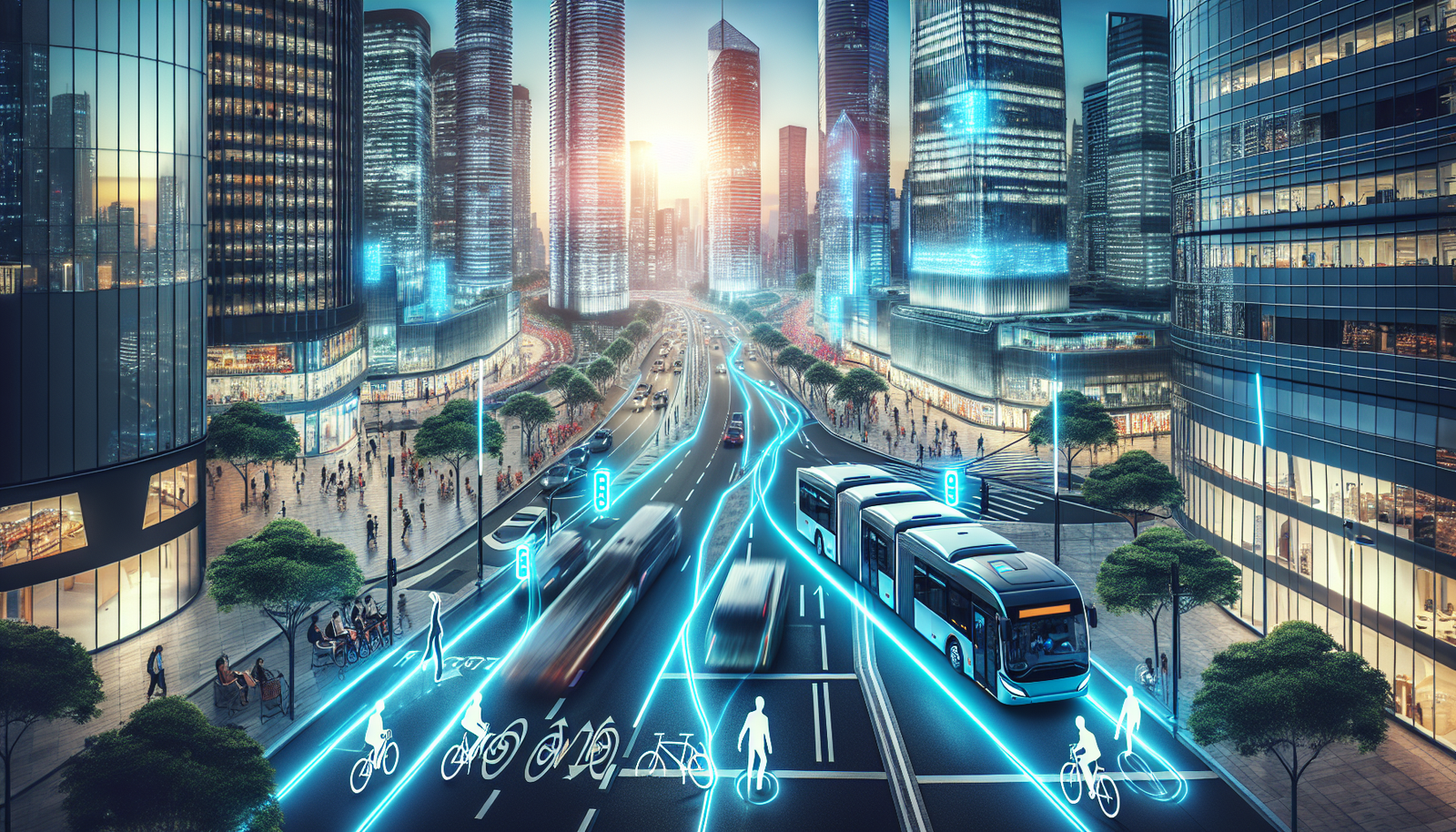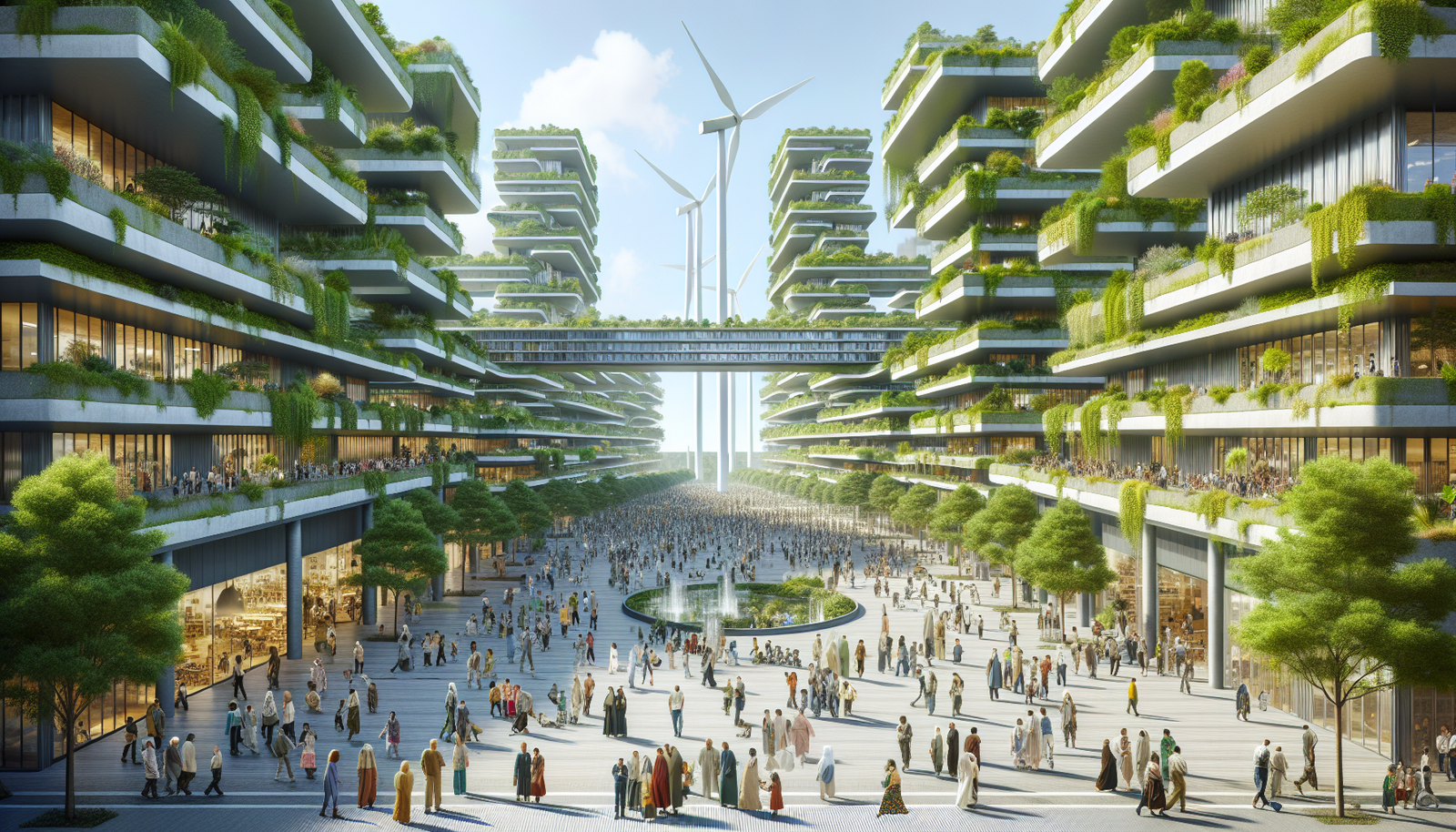The Role of AI in Transportation Planning
Artificial Intelligence (AI) is increasingly becoming a pivotal tool in the realm of transportation planning, offering innovative solutions that aim to enhance efficiency and sustainability. By leveraging AI, urban planners can analyze vast datasets to identify patterns and trends, facilitating more informed decision-making processes. This data-driven approach not only optimizes resource allocation but also enables the development of more effective transportation networks that align with sustainability goals.
One of the primary contributions of AI in transportation planning is its ability to optimize traffic flow and reduce congestion. Through the use of real-time data analysis, AI systems can adjust traffic signals dynamically to accommodate fluctuating traffic volumes, thereby minimizing idle time and reducing emissions. Additionally, AI-powered predictive analytics can forecast traffic patterns, allowing for proactive measures to manage congestion before it becomes problematic.
Furthermore, AI plays a crucial role in the integration of electric vehicles (EVs) into urban transportation systems. By analyzing data related to EV usage, charging station locations, and energy consumption, AI can help optimize the placement of charging infrastructure, ensuring that it is both accessible and efficient. This strategic placement is essential for encouraging EV adoption and supporting a transition to cleaner transportation alternatives.
AI also aids in the development of multi-modal transportation systems that promote eco-friendly urban mobility. By analyzing user preferences and transportation patterns, AI can suggest optimal routes that combine various modes of transport, such as biking, public transit, and walking, thus reducing reliance on single-occupancy vehicles. This holistic approach not only enhances the sustainability of urban transport but also improves the overall quality of life for city residents.
Predictive Analytics for Traffic Management
Predictive analytics plays a crucial role in enhancing traffic management by utilizing vast datasets to forecast traffic patterns and optimize flow. By analyzing historical traffic data, weather conditions, and real-time information, AI systems can predict congestion points and suggest alternative routes. This capability is essential for urban areas where traffic congestion contributes significantly to emissions. Cities like Los Angeles and New York have already started implementing these systems, resulting in a notable decrease in travel time and emissions.
The application of predictive analytics involves several steps, including data collection, data processing, and algorithmic predictions. The data is gathered from various sources such as GPS devices, traffic cameras, and social media feeds. Once processed, AI algorithms predict traffic volumes and potential bottlenecks. Machine learning models are particularly effective in this domain due to their ability to learn and improve over time with new data inputs.
An essential component of predictive analytics is the integration with existing traffic management systems. This integration allows for dynamic traffic signal adjustments and real-time route recommendations. Key benefits include reduced idle times at intersections and improved fuel efficiency. The table below illustrates how predictive analytics can impact traffic flow and emissions:
| Metric | Before Implementation | After Implementation |
|---|---|---|
| Average Travel Time (minutes) | 45 | 30 |
| CO2 Emissions (tons/day) | 500 | 350 |
The potential for AI-driven predictive analytics in traffic management extends beyond just reducing travel times and emissions. It also supports the integration of electric vehicles into the transport network by predicting optimal routes and charging station locations. This integration is vital for creating a sustainable and efficient urban mobility ecosystem.
Optimizing Public Transit Routes
Artificial Intelligence (AI) is revolutionizing the way public transit systems operate, by optimizing routes to enhance efficiency and reduce emissions. By analyzing vast amounts of data, AI algorithms can predict traffic patterns, identify bottlenecks, and suggest alternative routes that minimize travel time and fuel consumption. This not only leads to a more reliable public transit system but also significantly cuts down on greenhouse gas emissions.
One of the key components in optimizing transit routes is the use of real-time data analytics. AI systems can process data from various sources such as GPS, traffic cameras, and social media to provide transit agencies with actionable insights. For instance, by predicting peak hours and high-demand routes, AI can help in adjusting the frequency of buses or trains, ensuring that resources are allocated efficiently. This dynamic approach to route planning ensures that public transport remains an attractive option for commuters, further contributing to emission reduction.
Moreover, AI-driven optimization extends beyond just route planning. It includes the strategic placement of transit stops and the integration of multi-modal transport options. By utilizing AI, transit authorities can design routes that seamlessly connect with other modes of transportation, such as bike-sharing and electric scooters, creating a cohesive and sustainable urban mobility network. This not only improves accessibility for passengers but also encourages the use of public transportation over private vehicles.
Below is a simple representation of how AI can optimize public transit routes:
| AI Functionality | Benefits |
|---|---|
| Data Analysis | Identifies traffic patterns and predicts peak times. |
| Route Suggestion | Proposes optimal paths to reduce travel time and emissions. |
| Resource Allocation | Adjusts frequency of service based on demand. |
| Integration with Other Modes | Connects with bikes, scooters, and other transport methods. |
AI in Electric Vehicle Integration
Artificial Intelligence (AI) plays a pivotal role in the seamless integration of electric vehicles (EVs) into urban transportation systems. By leveraging AI algorithms, cities can optimize charging infrastructure, ensuring that EVs are charged efficiently and at times when energy demand is low. This not only reduces the strain on the grid but also minimizes the environmental impact of energy consumption.
One of the significant challenges in EV integration is the strategic placement of charging stations. AI assists in analyzing traffic patterns, demographic data, and energy usage to determine the most effective locations for these stations. This data-driven approach ensures that charging stations are accessible to a larger number of users, thereby encouraging the adoption of electric vehicles.
| Key Benefits of AI in EV Integration |
|---|
|
Furthermore, AI facilitates the integration of renewable energy sources into the EV charging infrastructure. By predicting energy production from sources like solar and wind, AI systems can intelligently manage when and where EVs are charged. This ensures that the maximum amount of renewable energy is utilized, further reducing emissions associated with electric vehicle charging.
In conclusion, AI is a crucial enabler in the transition to sustainable transportation. By optimizing various aspects of electric vehicle integration, AI not only supports the reduction of emissions but also enhances the overall efficiency and sustainability of urban transport systems.
Reducing Carbon Footprint with AI
Artificial Intelligence (AI) is playing a pivotal role in reducing the carbon footprint associated with transportation. By harnessing the power of AI algorithms, cities and transportation planners can significantly decrease emissions. One of the key ways AI contributes is through route optimization. By analyzing vast amounts of traffic data in real-time, AI can suggest the most efficient routes, thereby reducing fuel consumption and emissions. This is particularly beneficial for logistics companies that operate large fleets of vehicles, as even small efficiency improvements can result in substantial reductions in carbon output.
Moreover, AI aids in the integration of electric vehicles (EVs) into urban transportation systems. AI systems can predict demand for EV charging stations and optimize their placement to ensure maximum accessibility and efficiency. This not only encourages the adoption of EVs but also ensures that the electrical grid is used efficiently, preventing overloads and promoting a sustainable energy model. According to studies, cities that have implemented AI-driven EV infrastructure have seen a 15% increase in EV adoption within the first two years.
In addition to optimizing routes and supporting EV infrastructure, AI is also used in traffic management systems to reduce idle time at traffic signals. By employing advanced machine learning techniques, AI can dynamically adjust traffic light patterns based on real-time traffic conditions, thereby minimizing stop-and-go traffic, which is a major contributor to urban emissions. Cities that have adopted AI-driven traffic systems report up to a 10% reduction in vehicular emissions, highlighting the potential of AI in fostering sustainable urban environments.
To further illustrate the impact of AI on reducing transportation emissions, consider the following data:
| AI Strategy | Emission Reduction (%) |
|---|---|
| Route Optimization | 12% |
| Electric Vehicle Integration | 15% |
| Traffic Management Systems | 10% |
AI-Driven Smart Infrastructure
AI-driven smart infrastructure plays a crucial role in the advancement of sustainable transportation planning. By leveraging artificial intelligence, urban planners and policymakers can develop more efficient transportation networks that significantly reduce emissions. AI technologies facilitate the optimization of traffic flow, reducing congestion and minimizing idle times for vehicles, which in turn leads to decreased fuel consumption and lower greenhouse gas emissions. These intelligent systems can analyze vast amounts of data from various sensors and devices to make real-time adjustments to traffic signals, thereby enhancing the overall efficiency of transportation systems.
One of the key components of AI-driven smart infrastructure is the implementation of smart traffic management systems. These systems use AI algorithms to predict traffic patterns and make proactive adjustments to traffic lights and signage. For example, AI can process data from cameras and sensors installed at intersections to dynamically alter the timing of traffic signals, prioritizing the flow of public transit or emergency vehicles. This not only reduces delays but also promotes the use of sustainable transportation modes. Additionally, AI can assist in the planning and development of infrastructure projects by predicting future transportation needs and identifying potential bottlenecks before they become problematic.
Furthermore, AI-driven smart infrastructure supports the integration of electric vehicles (EVs) into urban environments. By optimizing the placement and operation of EV charging stations, AI ensures that these stations are conveniently located and accessible, encouraging more drivers to transition to electric vehicles. AI systems can analyze usage patterns and predict peak demand times, allowing for efficient energy distribution and reducing the strain on the electrical grid. The adoption of AI in this context not only aids in the reduction of emissions but also supports the broader goal of creating a sustainable and eco-friendly urban mobility network.
In summary, the implementation of AI-driven smart infrastructure is a transformative approach to sustainable transportation planning. By enhancing traffic management, supporting the integration of electric vehicles, and optimizing infrastructure development, AI technologies are paving the way for more sustainable cities. These advancements not only contribute to the reduction of emissions but also improve the quality of life for urban residents by creating more efficient, reliable, and environmentally friendly transportation systems.
Enhancing Cycling and Pedestrian Pathways
As urban areas seek to reduce their carbon footprint, enhancing cycling and pedestrian pathways has emerged as a critical strategy. AI technologies are playing an instrumental role in transforming these pathways into more efficient and user-friendly networks. By analyzing traffic patterns and pedestrian flows, AI systems can identify bottlenecks and suggest optimal locations for new pathways. This not only maximizes the use of available space but also ensures that these pathways serve the highest number of users effectively.
Data-driven Decision Making is at the heart of AI’s contribution to cycling and pedestrian infrastructure. Cities are employing AI algorithms to process data collected from various sources such as traffic cameras, mobile apps, and IoT devices. This information is then used to create heat maps that visualize the most frequently used routes and times of day. Such insights allow urban planners to prioritize areas that need immediate attention or expansion. For instance, a study in a major city revealed that by optimizing just 20% of the existing pathways, bicycle usage increased by 35%, significantly reducing urban emissions.
AI-enhanced pathway planning also incorporates safety measures, ensuring that pathways are not only convenient but also safe for users. AI systems can predict potential accident hotspots by analyzing historical accident data and real-time monitoring feeds. This enables the implementation of preventive measures such as better lighting, clearer signage, and even the redesign of intersections to enhance pedestrian and cyclist safety.
| City | Pathway Enhancement | Emission Reduction |
|---|---|---|
| Amsterdam | 30% increase in cycle lanes | 25% decrease in urban emissions |
| Copenhagen | Integration of AI traffic lights | 20% reduction in CO2 emissions |
Moreover, AI facilitates the integration of electric vehicles (EVs) with cycling and pedestrian pathways. By coordinating EV charging stations with popular cycling routes, cities can encourage multi-modal transport solutions. This integration not only supports eco-friendly travel but also reduces the dependency on fossil fuel-powered transport modes, further contributing to emission reduction goals.
AI and Urban Mobility Solutions
Artificial Intelligence (AI) is playing a crucial role in revolutionizing urban mobility by providing innovative solutions to reduce emissions and enhance the efficiency of transportation systems. As cities around the world grapple with the challenges of urbanization, AI-powered technologies are being harnessed to create smarter, more sustainable urban mobility solutions. One of the key areas where AI is making a significant impact is in route optimization. By analyzing vast amounts of traffic data in real-time, AI algorithms can identify the most efficient routes for public and private transportation, thereby reducing congestion and minimizing fuel consumption.
Electric Vehicle (EV) Integration is another area where AI is contributing to sustainable urban mobility. AI systems are being used to optimize the deployment and management of EV charging stations across cities. Through predictive analytics and machine learning models, AI can forecast demand for charging based on traffic patterns, weather conditions, and historical usage data. This ensures that charging infrastructure is optimally utilized and strategically expanded to meet future needs, supporting the transition to a zero-emission urban transport network.
Furthermore, AI is enhancing the development of shared mobility services such as ride-sharing and bike-sharing schemes. These services are pivotal in reducing the number of vehicles on the road and subsequently, emissions. AI algorithms help in optimizing the distribution and availability of these services by analyzing user demand patterns and adjusting supply in real-time. This not only improves user experience but also maximizes the environmental benefits through efficient resource utilization.
In addition to these applications, AI is also being used to improve public transportation systems. By implementing AI-driven predictive maintenance, public transport fleets can achieve higher reliability and efficiency. AI models can predict potential failures before they occur, allowing for proactive maintenance scheduling. This reduces downtime and ensures that public transport remains a viable and attractive option for urban commuters, further contributing to the reduction of transport-related emissions.
Data-Driven Policy Making
Data-driven policy making has emerged as a cornerstone in the quest for sustainable transportation solutions. By leveraging artificial intelligence and big data analytics, policymakers can gain unprecedented insights into traffic patterns, commuter behaviors, and environmental impacts. This approach enables the formulation of policies that are not only grounded in empirical evidence but are also dynamic, allowing for real-time adjustments as new data becomes available.
One of the key advantages of data-driven policymaking is its ability to optimize transportation networks. AI algorithms analyze vast datasets to identify bottlenecks and inefficiencies within the existing infrastructure. This information can be used to develop targeted interventions, such as adjusting traffic signal timings or redesigning bus routes, which can significantly reduce congestion and emissions. Moreover, the integration of predictive analytics allows for the anticipation of future trends, ensuring that transport policies remain relevant and effective over time.
To illustrate the impact of data-driven policies, consider the following example:
| Policy Initiative | Data Utilized | Outcome |
|---|---|---|
| Dynamic Traffic Management | Real-time traffic data | Reduced congestion by 30% |
| Electric Vehicle Incentives | Consumer purchase trends | Increased EV adoption by 20% |
In addition to optimizing existing systems, data-driven policymaking plays a crucial role in the integration of electric vehicles (EVs) into urban transport systems. By analyzing data on energy consumption, charging station usage, and travel patterns, AI can help identify optimal locations for new charging infrastructure, ensuring that it meets the needs of EV users while minimizing strain on the grid. This strategic planning is essential for encouraging widespread adoption of electric vehicles, which is a key component in reducing transportation-related emissions.
Challenges and Solutions in AI Implementation
The implementation of AI in sustainable transportation planning presents a myriad of challenges, primarily rooted in technological, infrastructural, and regulatory domains. One of the foremost challenges is the integration of AI systems with existing transportation infrastructure. Legacy systems often lack the compatibility required for seamless AI integration, resulting in increased costs and extended timelines for technology deployment. Furthermore, data privacy concerns pose significant hurdles, as the collection and analysis of transportation data necessitate robust privacy safeguards to prevent misuse and ensure public trust.
Another challenge is the computational complexity associated with AI models, which require substantial processing power and advanced algorithms to generate accurate predictions and optimizations. This complexity can lead to increased energy consumption, potentially offsetting the environmental benefits of AI-driven solutions. Additionally, there is a shortage of skilled professionals in the field, which hinders the development and maintenance of AI systems tailored to transportation needs.
Despite these challenges, several solutions have emerged to facilitate the effective implementation of AI in transportation. Collaborative frameworks between governments, private enterprises, and research institutions have been established to address technological and regulatory barriers. These partnerships focus on developing standardized protocols and systems that can be universally adopted, thereby reducing integration difficulties. Moreover, advancements in machine learning algorithms are enhancing the efficiency of AI models, enabling them to process data with greater accuracy and less computational power.
The adoption of cloud computing is another solution that mitigates the high processing power requirements of AI systems. By leveraging cloud-based platforms, transportation agencies can access scalable and flexible resources, reducing the need for extensive on-premise infrastructure. Additionally, ongoing education and training initiatives are being implemented to bridge the skills gap, ensuring that a new generation of professionals is equipped to manage and innovate within the AI-driven transportation sector. An example of such initiatives is the establishment of specialized courses and certifications in AI and transportation planning.
Case Studies of AI in Sustainable Transport
In recent years, numerous case studies have illustrated the significant impact of AI in advancing sustainable transportation. One notable example is the deployment of AI-driven traffic management systems in major cities like Amsterdam and Singapore. These systems utilize real-time data to optimize traffic flow, reduce congestion, and minimize emissions. By analyzing patterns and predicting traffic conditions, these AI solutions can dynamically adjust traffic signals and provide route recommendations to drivers, resulting in a substantial decrease in idle time and fuel consumption.
Another compelling case study can be seen in Los Angeles, where AI has been integrated into public transport planning to enhance efficiency and reduce carbon footprints. The city has implemented AI algorithms to analyze vast amounts of data from public transit systems, identifying patterns and peak usage times. This information is then used to optimize bus schedules and routes, ensuring that resources are allocated more effectively. As a result, Los Angeles has reported a significant reduction in emissions and an increase in public transport usage.
Electric vehicles (EVs) are also benefiting from AI applications, as demonstrated by a project in Oslo, Norway. Here, AI is used to manage the charging infrastructure for EVs, predicting demand and optimizing the distribution of charging stations across the city. This strategic placement and efficient management of charging resources have not only encouraged the adoption of electric vehicles but have also contributed to a noticeable decrease in transportation-related emissions. The integration of AI with EV infrastructure showcases how technology can facilitate the transition to cleaner energy sources in urban environments.
The table below summarizes the key outcomes from these case studies:
| City | AI Application | Outcome |
|---|---|---|
| Amsterdam & Singapore | AI-driven traffic management | Reduced congestion and emissions |
| Los Angeles | AI in public transport planning | Optimized routes and reduced emissions |
| Oslo | AI for EV charging infrastructure | Increased EV adoption and decreased emissions |
These case studies highlight the potential of AI in revolutionizing sustainable transport. By leveraging data-driven insights, cities can implement smarter strategies to achieve environmental goals, enhance mobility, and improve the quality of urban life. As AI technology continues to evolve, its application in sustainable transportation planning is expected to expand, offering even more innovative solutions for reducing emissions globally.
Future Prospects of AI in Transportation
The future prospects of AI in transportation are vast and hold the potential to revolutionize the way urban mobility is perceived and implemented. With AI’s ability to process large volumes of data quickly, transportation systems can be optimized to significantly reduce carbon emissions and energy consumption. By 2030, it is projected that AI technologies will contribute to a 10% reduction in global transport emissions, primarily through enhanced route optimization and traffic management systems.
One of the most promising aspects of AI in transportation is its role in integrating electric vehicles (EVs) into the urban fabric. AI can facilitate the efficient deployment and management of EV charging infrastructure, ensuring that charging stations are strategically located to meet demand without causing energy grid overloads. Furthermore, AI-driven predictive analytics can enhance battery management systems, extending the life of EV batteries and ensuring optimal performance.
In addition to these benefits, AI is set to transform public transportation by improving the reliability and efficiency of services. Through the use of AI algorithms, public transit systems can dynamically adjust schedules and routes based on real-time data, reducing wait times and improving the passenger experience. This adaptability is crucial for encouraging more people to use public transport, which is a key strategy in reducing urban traffic congestion and emissions.
The integration of AI in autonomous vehicle technology also presents a significant opportunity for future transportation systems. AI-enabled autonomous vehicles are expected to reduce traffic accidents by up to 90%, thanks to their ability to make split-second decisions and communicate with other vehicles and infrastructure. As these technologies continue to evolve, the potential for creating safer, more efficient, and environmentally friendly transportation networks becomes increasingly attainable.



